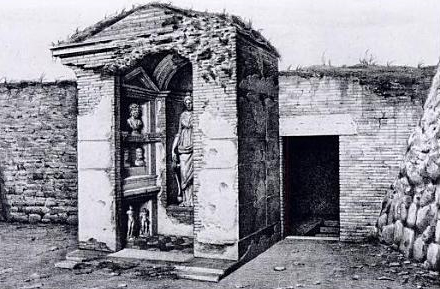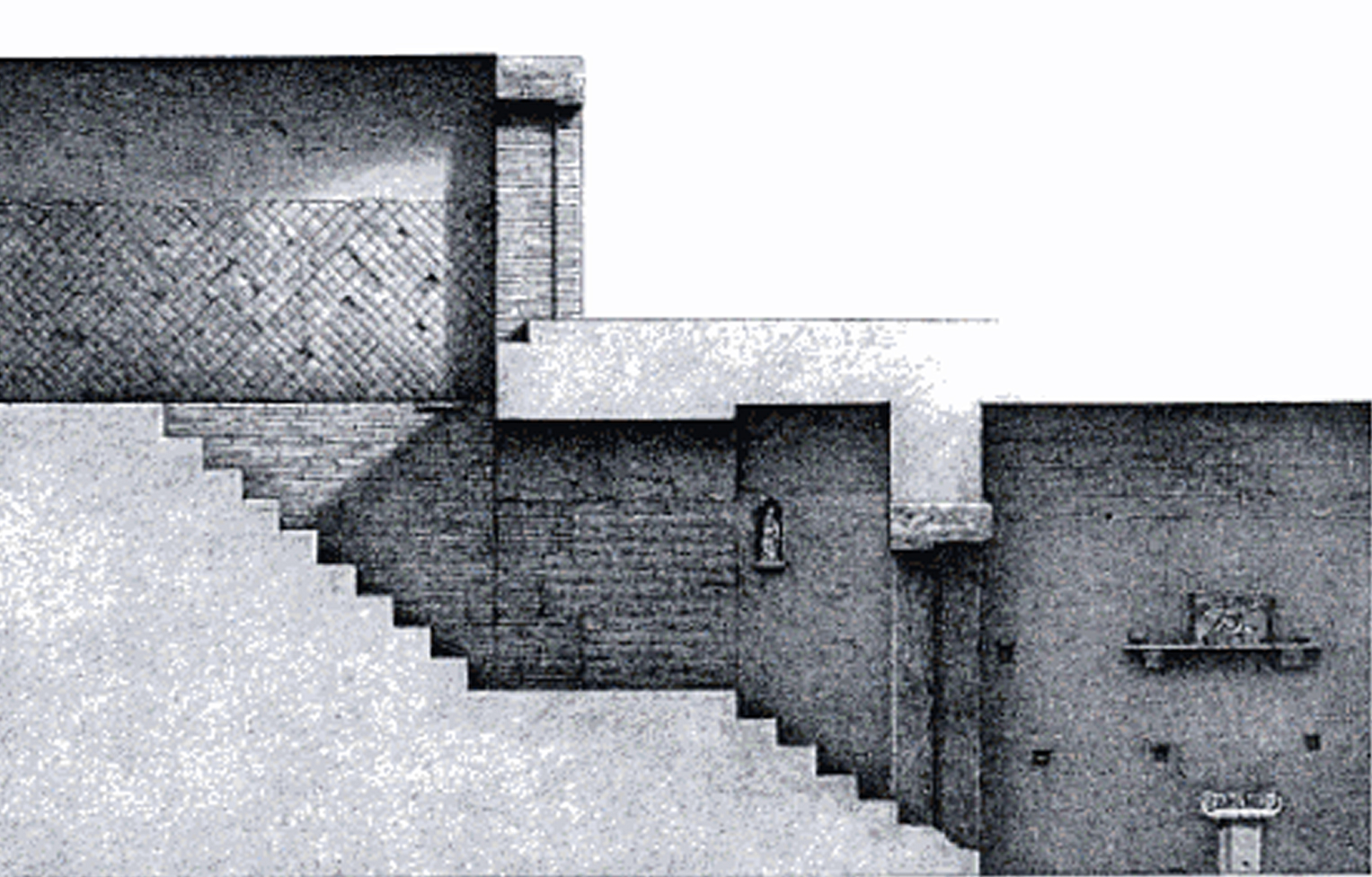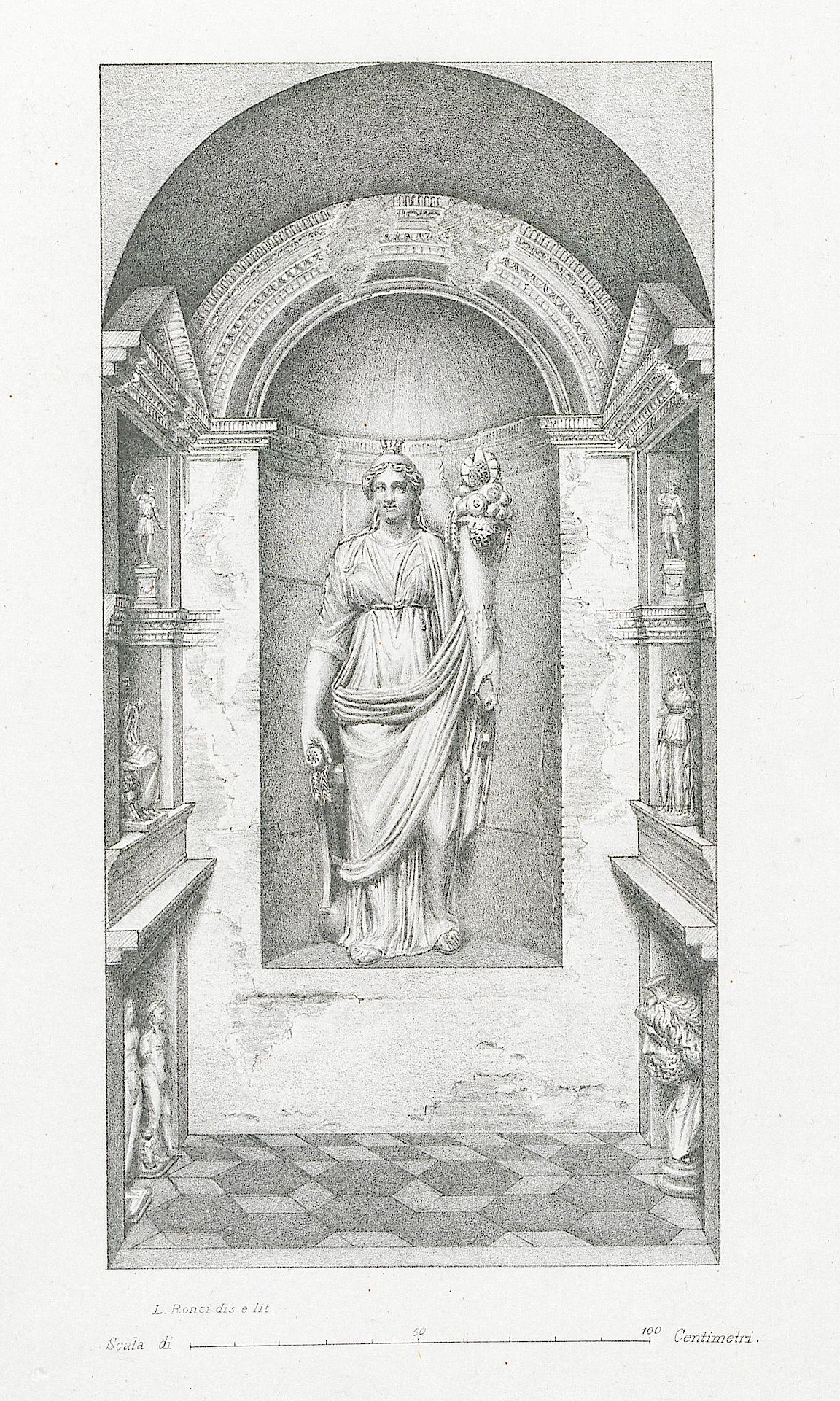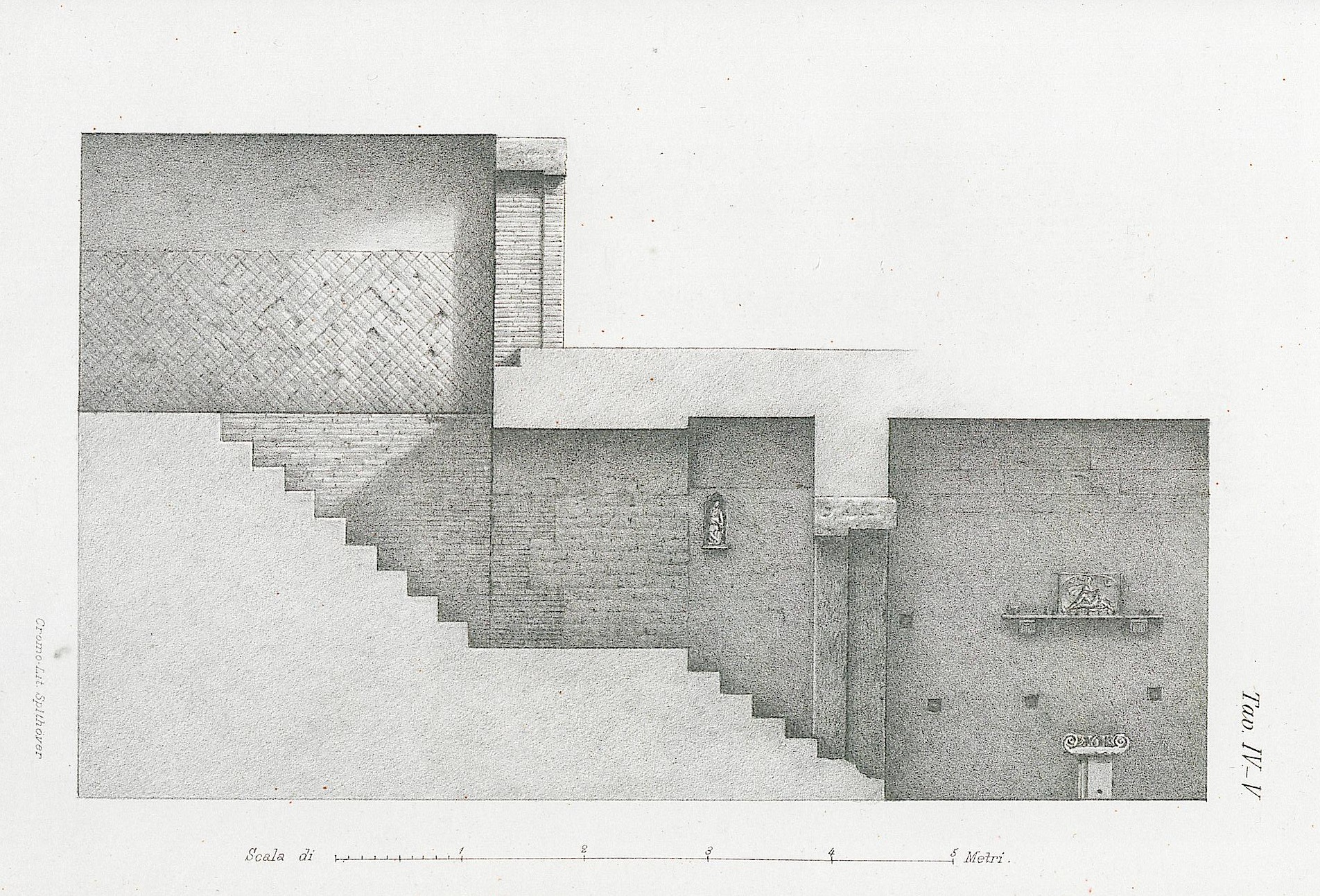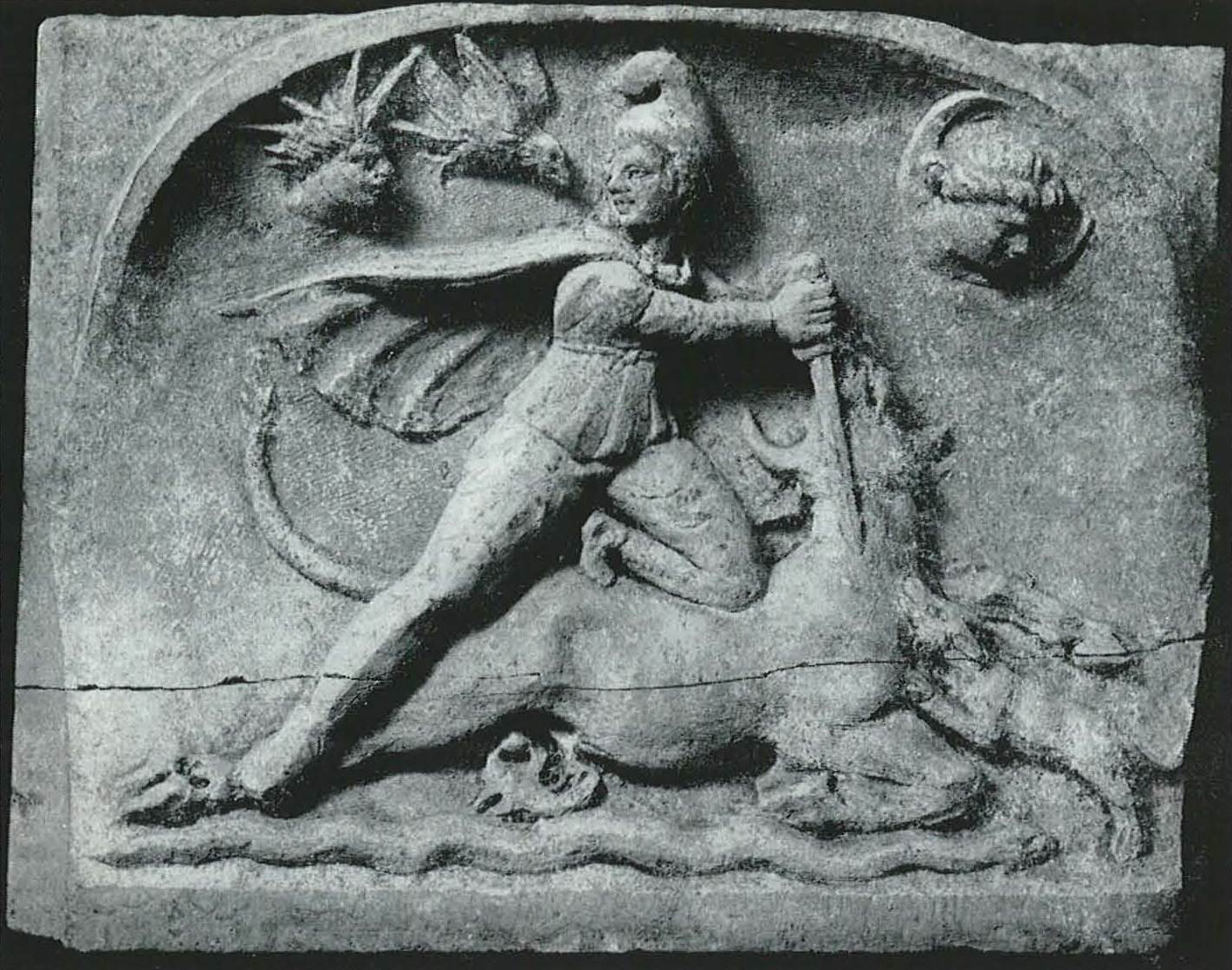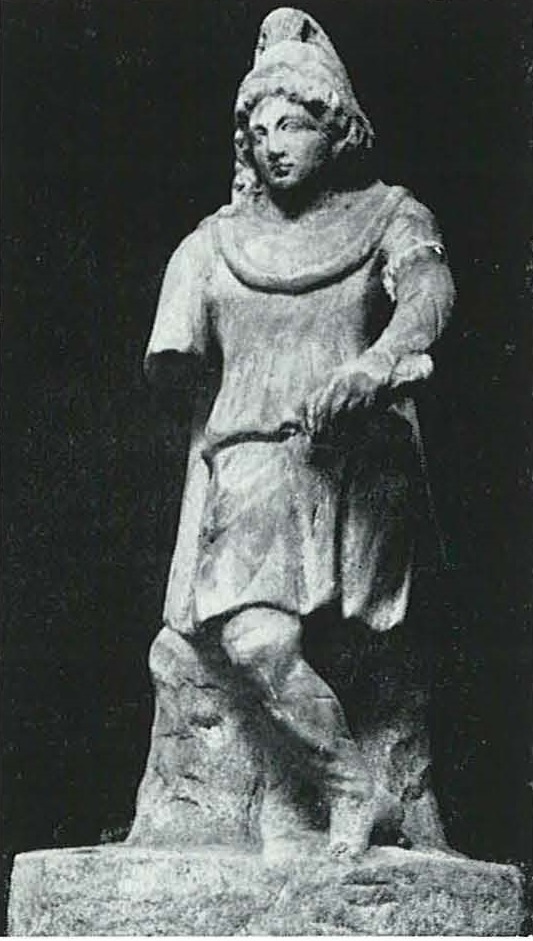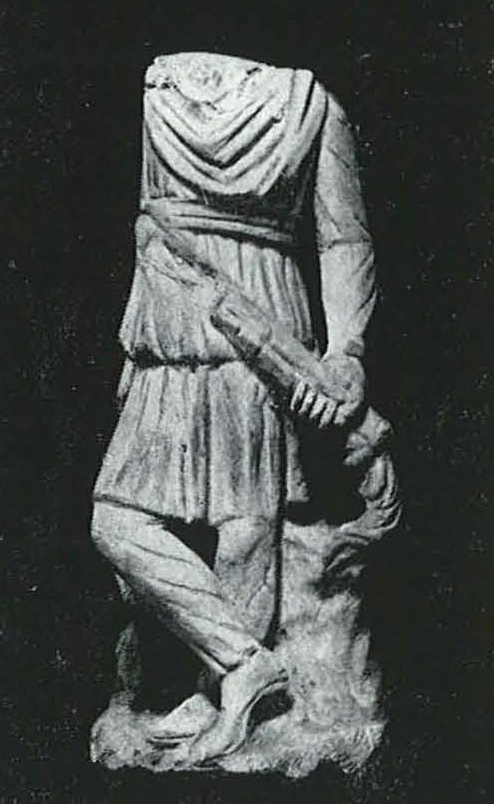
CIMRM 356, 357, 358, 359, 360 - Tiny Mithraeum at Via S.Giovanni Lanza 128. Esquiline Hill, Rome.
Tiny mithraeum @ Via S.Giovanni Lanza 128 (Esquiline Hill) Rome - dates to the reign of Constantine. It may be the mithraeum mentioned by Flavius Septimius Zosimus in CIL 6.733. Unlike most mithraea, it had no benches.
In 1883, during works to clean up the Esquiline Hill district, at Via S. Giovanni Lanza, behind the church of St. Martino ai Monti, the remains of some houses from late antiquity were discovered. A small edicule was found, with statues still in place (see left). This was a second-century construction, as a private shrine of Isis, which was converted into a Lararium in the 4th century house. A statue of Isis-Fortuna was inside, as were busts and statues of other household deities (Lares), including Serapis, Hercules, Horus-Harpocrates, Aphrodite, Dionysus, Apollo, Hecate, Cybele, and some statuettes of the lares familiarii. The edicule was demolished, but it was was drawn by L. Ronci. Next to the Lararium, a passage gave access to a stair down to a small chamber, rather older than the rest of the house. The walls are reticulated, and probably was originally a service area. In the fourth century it was turned into a tiny Mithraeum. Inside were found, still in place, votive items and ritual objects. Immediately at the foot of the first flight of stairs were statues of the two torchbearers, Cautes and Cautopates. On a shelf in the small room was a marble tauroctony of Mithras and the bull. In small cavities in the walls were found the remains of seven oil lamps and torches, perhaps symbolising the seven grades of initiation into Mithras. In the centre of the room was an Iconic column capital, being used as an altar.1
CIMRM entry
356
On the Esquiline (Via S. Giovanni Lanza 128) a Mithraeum was discovered near the Church of S. Martino ai Monti in 1883.
C. L. Visconti in BCM XIII, 1885, 27ff and Pls IV-V; Lanciani-Borsari in NSc 1885,67,154; Lanciani, Rome, 191, fig.; MMM II 199f No. 15 and fig. 25; Jordan, Top. Rom., I (3), 316f.
In a house from the time of Constantine or a little earlier, a Lararium was found with a statue of Isis-Fortuna and smaller statuettes of Sarapis, Jupiter, Hekate, Venus, Mars, Hercules and others. A door next to it opens on a lower room, which served as a Mithraeum. Via two flights of seven and nine steps, separated by a landing, one descends into it. On either side of this landing there is a niche in the wall, in which the two statues of Cautopates (l) (see below). In the r. niche traces of red-paint. The sanctuary itself consists of a small, arched room (L. 3.70 Br. 2.43). In one of the side-walls a marble slab has .been fixed (L. 1.23 Br. 0.36), which is supported by two brackets, which are decorated by leaf-work. On this slab we see a marble Mithras-relief (see below). Moreover there were some small vases (diam. 0.10) and the remnants of seven torches of fair-wood, which were covered with tar. Underneath the slab on the floor stood a square column with an upturned Ionian capital. The whole probably served as an altar. In the wall several small niches have been hewn out. Four of them, two arched and two square ones, are on the left between the entrance and the cult-niche, two more below the marble slab and two to the left of it, and finally one more in the opposite wall. They probably contained the lamps.
357.
White marble relief (H. 0.325 Br. 0.44 D .. 0.03-0.0Sf, in the Mus. Capitolino. together with the two following Nos. See fig; 102.
Under an arch, Mithras slaying the bull, whose tail ends in one ear. The serpent, the dog and the scorpion are present. The god is dressed in short tunic and anaxyrides; he is looking at the raven and at Sol, who has five rays around his head. In the r. upper corner the head of Luna in a crescent. It is kept down to the right.
358.
White marble statue (H. 0.34 Br. base 0.16). See fig. 103.
Standing torchbearer in Eastern attire, cross-legged. At his feet a trunk. The r. arm and the greater part of the torch are broken off. Cautopates.
359.
White marble statue (H. 0.25 Br. 0.11). See fig. 104. Standing Cautopates in the. same attire and attitude. Next to his feet a trunk and r. an owl. The r. arm and head got lost.
360.
In ecclesia S. Martini in Montibus, ara rotunda sertis a cranis bubulis dependentibus circundata. (In the church of S. Martino ai Monti, a round altar surrounded by garlands hanging from the head of a bull)
CIL VI 733; MMM II No. 61.
Deo Soli invicto Mitrhe(sic!) / Fl. Septimius Zosimus v(ir) p(erfectissimus) / sacerdus(sic!) dei Brontontis et Aecate hoc speleum constituit.
The inscription may or may not be connected to the Mithraeum.
Note that the BCM article is very detailed.
External links
- A. B. Griffith, "Mithraism in the private and public lives of 4th-c. senators in Rome: "This mithraeum on the Esquiline hill, associated with a garden lararium and domus, is important for understanding the 4th-c. cult of Mithras.[vi] It is a problematic sanctuary for several reasons: its layout does not conform to typical mithraea in every respect, its owner cannot be identified, and it is difficult to date precisely. The subterranean sanctuary accessed by two flights of stairs was uncharacteristically small and nearly square (l. 3.7 m x w. 2.43 m) and lacked sufficient space for the requisite kline (dining couches), but statues of Cautes and Cautopates in niches at the landing on the stairwell, a tauroctony relief resting on two brackets on the left wall of the sanctuary, and the 4 niches for the lamps recovered during the excavation confirm its identity. Clauss firmly states what Vermaseren only tentatively suggested: that the owner of this domus and mithraeum was one Flavius Septimius Zosimus, who stated in a dedicatory inscription that he was a vir perfectissimus and sacerdos of Bronto and Hecate, and that he built a Mithraic cave (speleum).[vii] I would emphasize that this dedication found its way to the church of San Martino ai Monti and that the exact provenience and the circumstances of its discovery are unknown. However tempting it may be to associate this individual with the owner of the mithraeum, lararium, and domus, we cannot do so securely.
"Dating the mithraeum, the lararium, and the associated domus with any precision has also proven difficult. In his analysis of the domus in late-antique Rome, Frederico Guidobaldi considered the excavation reports carefully and has confirmed the “Constantinian” date originally suggested by the excavators, although he noted that the domus, lararium, and mithraeum were all installed in earlier structures which could date any time from the late 1st c. B.C. through the 2nd c. A.D.[viii] Most other indicators are too general to be helpful. Garden lararia were common enough that the presence of one here cannot help to determine a date. The arrangement of lararium and mithraeum recalls the garden lararium and biclinium at the Domus Fulminata at Ostia, but even if we posit a biclinium at the Via Giovanni Lanza lararium, a handy substitution for the kline lacking from the mithraeum, the Domus Fluminata is generally dated to the 1st and 2nd c.[ix] Neither is the presence of a mithraeum on the grounds of domus a good indicator because mithraea in domus and insulae are documented in the middle of the 2nd c. in Ostia and during the Severan period in Rome. What is most useful for supporting a “Constantinian” date is the presence of a mithraeum in a particularly well-appointed domus containing certain architectural features which might indicate a 4th-c. date, as here, [x] and the remarkable variety of deities in the lararium. Taken as a whole the group of 17 figures contained a life-size statue of Egyptian Isis, and statuettes of Serapis, Horus, and Mithras among the more traditional Jupiter, Diana, Venus, Mars, Hercules, Dionysus (represented by a bacchant), two lares, and a genius (of what Visconti declined to say). Now of all these deities, Mithras’ arrival was by far the most recent in Rome, and even it can be reasonably dated around A.D. 90.[xi] Inscriptions dedicated by senators in the 4th c. to Magna Mater in the Vatican Phrygianum, however, mention not only Magna Mater and Attis Menotyrannus, but also Mithras, Hecate, Liber, and Isis. These are not merely joint dedications, as we shall see presently, but a list of priesthoods in each of these cults. The variety of this list immediately calls to mind the group of statues from the Via Giovanni Lanza lararium.
[vi] The main publication about it is brief but pithy and includes several drawings: C. Visconti, “Del larario e del mitreo scoperti nell’Esquilino presso la chiesa di S. Martino ai Monti,” BCR (1885) 27-38 and pls. 3-5. The finds are summarized in the two major catalogues of Mithraic monuments: CIMRM 356-59 and TMMM 2.15. See also M.J. Vermaseren, De Mithrasdienst in Rome (1951) 75-6 for a discussion of monuments in Rome and more recently, S. Ensoli Vittozzi, “Le sculture del ‘larario’ di S. Martino ai Monti. Un constesto recuperato,” BCR 95 (1993) 221-43. J. Calzini Gysens, “Mithra, Spelaeum (Via G. Lanza 128; Reg. V),” in E. M. Steinby (ed.), Lexicon Topographicum Urbis Romae, Vol. III: H-O (Rome 1993) 260-61 provides a brief summary of the excavators’ reports, complete with contemporary and subsequent bibliographic references which discuss this mithraeum.
[vii] CIL VI.733=ILS 4226=CIMRM 360=TMMM 2.61. Clauss, op. cit., 1992 (n.3), 26. Vermaseren, op. cit. (n.6),75-76. Vermaseren tentatively suggested that the dedication to “Deo Soli Invicto Mithre (sic)” might belong to a mithraeum close by such as the Via Giovanni Lanza sanctuary, but pointed out that no definite conclusion was possible. F. Coarelli, “Topografia Mitriaca di Roma,” in U. Bianchi (ed.), Mysteria Mithrae (EPRO v. 80) (1979) 60-79 at 71 did not associate the mithraeum with this inscription.
[viii] F. Guidobaldi, “L’edilizia abitava unifamiliare nella Roma tardoantica,” in A. Giardina (ed.), Società Romana e impero tardoantico II: Roma: politica, economia, paesagio urbano (1986) 194-98. The lararium is brick, the entrance to the mithraeum is brick above opus reticulatum, the stairway walls are brick and tufa, and the mithraeum tufa. Calzini Gysens, op. cit. (n.6) agrees.
- Mitreo di via Giovanni Lanza, at Roma Sotteranea.
| 1 | This description translated from the Roma Sotteranea article, as it makes the layout rather clearer than the CIMRM description does. |
| Tweet |
